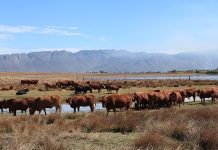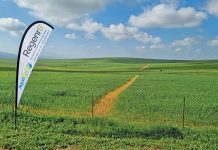Thanks to the competitive nature of the dairy industry, dairy cattle breeds worldwide are suffering very high levels of inbreeding. While the widespread import and export of quality semen and embryos have made the industry more productive than ever, breeders worldwide are using a relatively small number of sires and families. While there are about 1 million Holstein dairy cows in the US, only 300 young sires are progeny-tested annually.
Out of these, the 30 that may be kept for extensive use are used worldwide, and for breeding AI sires in other countries. In SA, as in other countries, young sires are mostly related to other sires used internationally. T his narrowing genetic base means the pedigrees of today’s young bulls can be traced back to relatively few sires. In fact, six Holstein bulls currently dominate the pedigrees of progeny test bulls globally. For the four major dairy breeds – Ayrshire, Guernsey, Holstein and Jersey – the proportion of progeny sired by foreign sires in SA between 2000 and 2003, ranges from 25% to 36%.
It’s breeding for negative traits Inbreeding compromises traits associated with fertility and survival. It can have insidious effects that aren’t readily noticed, reducing conception rates and disease resistance, increasing early embryonic loss, compromising mothering ability, and extending intercalving intervals. Dr Helena Theron, ARC quantitative breeding programme manager, urges farmers to take precautions when breeding.
“Inbreeding is usually associated with malformed calves, but at high levels it actually messes with fertility and survivability – fewer calves are born, and those that are tend to get sick and die more easily,” she warns. “It robs producers of profit and can significantly decrease performance – so much so that the term ‘inbreeding depression’ was coined.”
Inbreeding increases the likelihood of unwanted genetic disorders, such as deficiency of uridine 5’-monophosphate synthase (DUMPS) which causes abortions, and bovine leukocyte adhesion deficiency (BLAD) which compromises mucosal immunity and causes complex vertebral malformation (CVM). “CVM was first identified in Holsteins in early 2000 as a result of inbreeding, and has been traced back to the bull Carlin-M Ivanhoe Bell, a very successful Holstein AI bull born in 1974,” says Helena. “One of the biggest spread of the disorder are the many daughters Bell sired in many countries. Fortunately, carriers can be detected with a lab test.”
CVM is characterised by malformations of the backbone (scoliosis) and sometimes by heart defects. However, 93% of affected calves are aborted, so cows in affected herds tend to have long calving intervals, or show recurring heat. Look at the pedigree Many producers are unaware that cows in their herd have high inbreeding coefficients.
“Farmers must look at pedigree information before mating or inseminating cows, as the problem is only going to get worse in future,” warns Dr Theron. Dr Japie van der Westhuizen, team leader for animal recording and improvement at the ARC Animal Production Institute, agrees. “One way to manage inbreeding will be through the National Recording Database (INTERGIS), which is open to all farmers participating in the National Milk Recording and Improvement Scheme, as well as the breeders’ societies,” he says. “Computations from the recorded data help users identify closely related animals in breeding programmes.
SA has one of the most advanced recording systems in the world.” In milk recording, cows’ inbreeding coefficients are printed on the herd profile, but are only accurate if pedigree information is up to date (see box: Inbreeding coefficients). A three-generation pedigree for each cow is also available.
Crossbreed to cure? Dr Les Hansen, a dairy scientist at the University of Minnesota, says an effective, but extremely controversial way to undo inbreeding and introduce hybrid vigour is fixed rotational crossbreeding.
He strictly specifies that such a system should use three breeds – no more, no less. Dr Hansen says crossbreeding systems that only use two breeds will limit the impact of hybrid vigour, but using three, such as Holstein, Swedish Red and Montbeliarde, increases average hybrid vigour by 19%.
However, adding a fourth breed increases average hybrid vigour by only 6%. “Crossbreeding should be regarded as a mating system that complements genetic improvement within breeds,” Dr Hansen says. “Continuous use of progeny-tested and highly-ranked AI bulls is crucial to genetic improvement, regardless of the mating system. Hybrid vigour is a bonus, alongside the positive genes obtained from top AI bulls within a breed.” Contact Dr Helena Theron on (012) 672 9070 or e-mail [email protected]. |
How severe is inbreeding in SA cattle?
In SA, the Jersey population exhibits the highest annual rate of inbreeding (0,07%) followed by the Holstein (0,06%), Ayrshire and the Guernsey breeds (at 0,05%). While they’re climbing, they’re currently safe – and the quicker awareness of the pitfalls of inbreeding spread, the quicker the escalation can be brought to heel. In 2006, ARC Animal Production Institute researchers Bernice Mostert and Norman Maiwashe found that inbreeding in SA is undeniably climbing.
“The annual mean inbreeding level of the four main breeds shows an exponential increase, which is consistent with results from other countries,” says the ARC’s Dr Helena Theron. “Between 1960 and 1990 there was a mild increase in the level of inbreeding. Then the use of AI increased and 1990 to 2003 showed a rapid increase for all the breeds. In 2003, the mean inbreeding levels were 2,02% for Ayrshires, 2,04% for Guernseys, 2,30% for Holsteins and 3,05% for Jerseys.”
However, the rate of inbreeding, which measures the increase in inbreeding per generation, is also important. “Internationally it’s at 1% to 1,5% per generation – a worrying level,” says Dr Theron. “0,5% a year is acceptable.” Dr Hansen found that inbreeding has been increasing at a relatively constant rate of 0,15% per year for US Holsteins and 0,2% per year for US Jerseys. However, the genetic variability within SA dairy breeds is still higher than in the US. “SA’s level of inbreeding is considerably lower than 0,5% per year, and lower than estimates of inbreeding obtained 15 years ago in the US,” Dr Theron says.
Considerations when managing inbreeding
Since increased relationships are the consequence of using only a few sires in an AI breeding programme, inbreeding can’t be avoided without sacrificing progress toward improved productivity. Choose the sire with the highest genetic merit, adjusted for inbreeding in a specific mating.
Don’t avoid using the best sons of a good bull because he has daughters in the herd, but do avoid mating particular bulls and cows. Inbreeding can’t be avoided unless a cow’s pedigree is known in depth. Much of the damage from inbreeding comes from common ancestors three or more generations back, and a complete pedigree needs to record four or five generations back. Estimated inbreeding coefficients in grade cattle were three times higher than in registered cattle because of missing ancestors. In milk Recording, inbreeding coefficients are calculated for all cows and bulls and available on herd-profiles and on Logix.
One of the most valuable assets of a registered cow is the ability to assign her mates. However, the information isn’t much use unless it’s available in a format usable by computerised mating programmes. Using AI rather than natural service bulls gives better control of inbreeding since individual matings can be planned. AI bulls are also tested for genes like CVM, BLAD and DUMPS, but many AI sires are related to one another and to cows, and breeders should study pedigrees carefully. Slow inbreeding allows selection (natural and deliberate) to remove the less fit animals, which isn’t always possible with fast inbreeding. It’s therefore possible to have an animal that’s highly inbred without negative effects.
Also, the faster the rate of inbreeding, the faster the loss of genetic variation within a population. It’s the rate of inbreeding, rather than the level of inbreeding, that should be monitored and controlled.








